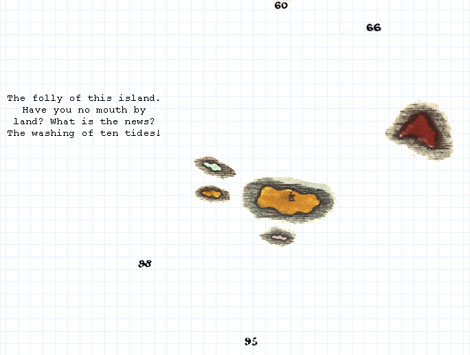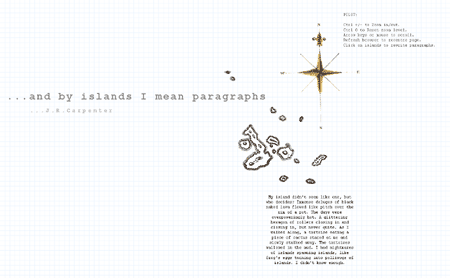On Friday 14 March 2014 I will present a performance paper called “Seven Short Talks About Islands . . . and by islands I mean paragraphs” at MODULAR FORM: A SYMPOSIUM ON CREATIVE PRACTICE, a one-day symposium hosted by ReWrite, the Centre for Research in Creative and Professional Writing at Roehampton University, in conjunction with Writing-PAD.
…and by islands I mean paragraphs is a web-based work which is both composed and displayed in a modular format. A sea of white space extends far beyond the horizon of the browser window, to the north, south, east and west. Navigating (with mouse, track pad, or arrow keys) reveals that this sea is dotted with islands… and by islands I mean computer-generated paragraphs. These fluid JavaScript compositions draw upon variable strings containing fragments of text harvested from a vast literary corpus – Deluze’s Desert Islands, Shakespeare’s The Tempest, Defoe’s Robinson Crusoe, Bishop’s Crusoe in England, Coetzee’s Foe, Ballard’s Concrete Island, Hakluyt’s Voyages and Discoveries, and many other lesser-known sources including an out-of-date guidebook to the Scottish Isles and an amalgam of accounts of the classical and possibly fictional island of Thule. Individually, each of these textual islands represents a topic from the Greek topos, meaning place. Collectively they constitute a topographical map of a sustained practice of reading and re-reading and writing and re-writing on the topic of islands. In this constantly shifting sea of variable texts one will never find the same island twice… and by islands, I really do mean paragraphs.

… and by islands I mean paragraphs || J. R. Carpenter 2013
I will present this modular work in a modular format loosely informed by Anne Carson’s Short Talks and Judith Schalansky’s Atlas of Remote Islands: Fifty Islands I Have Never Set Foot On and Never Will. I will offer a brief introduction, and then navigate the work. As I come across textual islands I will offer short ‘talks’ on them. Each of these ‘talks’ will be composed of a selection of the fragments contained in that particular island’s variable strings.
For example, here is a ‘talk’ based on an island composed of fragments of text from “A Topical Paradise,” an essay by Hernán Díaz:
Islands are [‘places that have become commonplaces’, ‘perfect topics’, ‘literal metaphors’, ‘possible only in literature’]. Topical islands are [‘figures of radical isolation’, ‘off the map’, ‘off the chart’, ‘always virgin’, ‘blind spots on the surface of the known’, ‘shrouded in obscurity’, ‘isolated in the present’, ‘silent’, beyond time’, ‘in a time zone of their own’]. They are paragraphs. They [‘separate the narrative body from the referential mainland’, ‘separate the text from the writer’s desk’, ‘separate the text from the reader’s finger’s’, ‘surround and enclose the text’, ‘create their own context’]. They are [‘textual shores’, ‘marginal’, ‘not part of the central body of the text’, ‘a physical space on the page’, ‘engulfed in a textual sea’].
And here is a ‘talk’ based on an island composed of fragments of text from J. M. Coetzee’s novel Foe:
I am [‘cast away’, ‘a castaway’, ‘indeed cast away’, ‘not a bird of passage’, ‘not a prisoner’, ‘not a story’, ‘not persuaded’, ‘unknown to myself’, ‘wondering how I come to be here’, ‘saved’, ‘on an island yet’, ‘alone on the waves’, ‘alone’, ‘all alone’, ‘a woman alone’, ‘a woman cast ashore’, ‘a woman washed ashore’, ‘a free woman’, ‘now a madwoman’, ‘waiting for the book to be written that will set me free’].

… and by islands I mean paragraphs || J. R. Carpenter 2013
Practitioners have been invited to MODULAR FORM: A SYMPOSIUM ON CREATIVE PRACTICE from a diverse range of fields, including digital writing, performance art, curatorial studies, poetry, music, and psychoanalysis, to discuss the deployment of short and/or minimal units of text.
MODULAR FORM CONTRIBUTORS AND TEXTS
J.R. Carpenter, “Seven Short Talks About Islands …and by islands I mean paragraphs.”
Vincent Dachy, “Free Associations! Or Weaving with the Wind.”
James Davies, “Minimalism and Modularity.”
Rupert Loydell and Kingsley Marshall, “CONTROL & SURRENDER. Eno Remixed: Collaboration & Oblique Strategies.”
Kaja Marczewska, “Modular form as a Curatorial Practice.”
Nathan Walker, “Six Words Short: Textual Instruction Events.”
ROEHAMPTON UNIVERSITY
The symposium will be held at Grove House on the main campus of Roehampton University on Friday, March 14, 2014, from 10 am to 5 pm.
The symposium is free but places are limited, so please book early to avoid disappointment. The event includes a catered lunch.


![J. R. Carpenter || Notes on the Voyage of Owl and Girl [detail]](http://luckysoap.com/lapsuslinguae/images/owlandgirl_detail5.jpg)
![TRANS.MISSION [A.DIALOGUE]](http://luckysoap.com/generations/images/trans_sourcedetail.gif)
 This beautiful bilingual issue #66 of the French Magazine MCD (musiques & cultures digitales) is dedicated to Writing Machines: literature, performance and media in the digital age. It was edited by Emmanuel Guez and contains articles by and/or about Annie Abrahams, Serge Bouchardon, Philippe Bootz, Laura Borràs, Peter Ciccariello, Katherine Hayles, Jorg Piringer, Alexandra Saemmer, Brian Stefans, and many many more.
This beautiful bilingual issue #66 of the French Magazine MCD (musiques & cultures digitales) is dedicated to Writing Machines: literature, performance and media in the digital age. It was edited by Emmanuel Guez and contains articles by and/or about Annie Abrahams, Serge Bouchardon, Philippe Bootz, Laura Borràs, Peter Ciccariello, Katherine Hayles, Jorg Piringer, Alexandra Saemmer, Brian Stefans, and many many more. 



